美赛-数学建模-写作模版(各部分)
数学建模文章格式模版word版(共5篇)
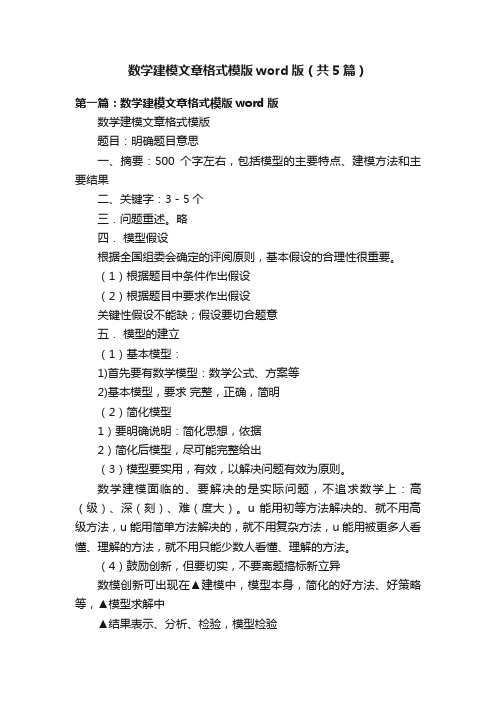
数学建模文章格式模版word版(共5篇)第一篇:数学建模文章格式模版word版数学建模文章格式模版题目:明确题目意思一、摘要:500个字左右,包括模型的主要特点、建模方法和主要结果二、关键字:3-5个三.问题重述。
略四.模型假设根据全国组委会确定的评阅原则,基本假设的合理性很重要。
(1)根据题目中条件作出假设(2)根据题目中要求作出假设关键性假设不能缺;假设要切合题意五.模型的建立(1)基本模型:1)首先要有数学模型:数学公式、方案等2)基本模型,要求完整,正确,简明(2)简化模型1)要明确说明:简化思想,依据2)简化后模型,尽可能完整给出(3)模型要实用,有效,以解决问题有效为原则。
数学建模面临的、要解决的是实际问题,不追求数学上:高(级)、深(刻)、难(度大)。
u 能用初等方法解决的、就不用高级方法,u 能用简单方法解决的,就不用复杂方法,u 能用被更多人看懂、理解的方法,就不用只能少数人看懂、理解的方法。
(4)鼓励创新,但要切实,不要离题搞标新立异数模创新可出现在▲建模中,模型本身,简化的好方法、好策略等,▲模型求解中▲结果表示、分析、检验,模型检验▲推广部分(5)在问题分析推导过程中,需要注意的问题:u 分析:中肯、确切u 术语:专业、内行;;u 原理、依据:正确、明确,u 表述:简明,关键步骤要列出u 忌:外行话,专业术语不明确,表述混乱,冗长。
六.模型求解(1)需要建立数学命题时:命题叙述要符合数学命题的表述规范,尽可能论证严密。
(2)需要说明计算方法或算法的原理、思想、依据、步骤。
若采用现有软件,说明采用此软件的理由,软件名称(3)计算过程,中间结果可要可不要的,不要列出。
(4)设法算出合理的数值结果。
七、结果分析、检验;模型检验及模型修正;结果表示(1)最终数值结果的正确性或合理性是第一位的;(2)对数值结果或模拟结果进行必要的检验。
结果不正确、不合理、或误差大时,分析原因,对算法、计算方法、或模型进行修正、改进;(3)题目中要求回答的问题,数值结果,结论,须一一列出;(4)列数据问题:考虑是否需要列出多组数据,或额外数据对数据进行比较、分析,为各种方案的提出提供依据;(5)结果表示:要集中,一目了然,直观,便于比较分析▲数值结果表示:精心设计表格;可能的话,用图形图表形式▲求解方案,用图示更好(6)必要时对问题解答,作定性或规律性的讨论。
美赛:全国大学生数学建模竞赛论文格式规范---论文写作规范

全国大学生数学建模竞赛论文格式规范●本科组参赛队从A、B题中任选一题,专科组参赛队从C、D题中任选一题。
(全国评奖时,每个组别一、二等奖的总名额按每道题参赛队数的比例分配;但全国一等奖名额的一半将平均分配给本组别的每道题,另一半按每题论文数的比例分配。
)●论文用白色A4纸打印;上下左右各留出至少2.5厘米的页边距;从左侧装订。
●论文第一页为承诺书,具体内容和格式见本规范第二页。
●论文第二页为编号专用页,用于赛区和全国评阅前后对论文进行编号,具体内容和格式见本规范第三页。
●论文题目、摘要和关键词写在论文第三页上(无需译成英文),并从此页开始编写页码;页码必须位于每页页脚中部,用阿拉伯数字从“1”开始连续编号。
注意:摘要应该是一份简明扼要的详细摘要,请认真书写(但篇幅不能超过一页)。
●从第四页开始是论文正文(不要目录)。
论文不能有页眉或任何可能显示答题人身份和所在学校等的信息。
●论文应该思路清晰,表达简洁(正文尽量控制在20页以内,附录页数不限)。
●引用别人的成果或其他公开的资料(包括网上查到的资料) 必须按照规定的参考文献的表述方式在正文引用处和参考文献中均明确列出。
正文引用处用方括号标示参考文献的编号,如[1][3]等;引用书籍还必须指出页码。
参考文献按正文中的引用次序列出,其中书籍的表述方式为:[编号] 作者,书名,出版地:出版社,出版年。
参考文献中期刊杂志论文的表述方式为:[编号] 作者,论文名,杂志名,卷期号:起止页码,出版年。
参考文献中网上资源的表述方式为:[编号] 作者,资源标题,网址,访问时间(年月日)。
●在论文纸质版附录中,应给出参赛者实际使用的软件名称、命令和编写的全部计算机源程序(若有的话)。
同时,所有源程序文件必须放入论文电子版中备查。
论文及源程序电子版压缩在一个文件中,一般不要超过20MB,且应与纸质版同时提交。
(如果发现程序不能运行,或者运行结果与论文中报告的不一致,该论文可能会被认定为弄虚作假而被取消评奖资格。
美赛数学建模比赛论文模板

The Keep-Right-Except-To-Pass RuleSummaryAs for the first question, it provides a traffic rule of keep right except to pass, requiring us to verify its effectiveness. Firstly, we define one kind of traffic rule different from the rule of the keep right in order to solve the problem clearly; then, we build a Cellular automaton model and a Nasch model by collecting massive data; next, we make full use of the numerical simulation according to several influence factors of traffic flow; At last, by lots of analysis of graph we obtain, we indicate a conclusion as follow: when vehicle density is lower than 0.15, the rule of lane speed control is more effective in terms of the factor of safe in the light traffic; when vehicle density is greater than 0.15, so the rule of keep right except passing is more effective In the heavy traffic.As for the second question, it requires us to testify that whether the conclusion we obtain in the first question is the same apply to the keep left rule. First of all, we build a stochastic multi-lane traffic model; from the view of the vehicle flow stress, we propose that the probability of moving to the right is 0.7and to the left otherwise by making full use of the Bernoulli process from the view of the ping-pong effect, the conclusion is that the choice of the changing lane is random. On the whole, the fundamental reason is the formation of the driving habit, so the conclusion is effective under the rule of keep left.As for the third question, it requires us to demonstrate the effectiveness of the result advised in the first question under the intelligent vehicle control system. Firstly, taking the speed limits into consideration, we build a microscopic traffic simulator model for traffic simulation purposes. Then, we implement a METANET model for prediction state with the use of the MPC traffic controller. Afterwards, we certify that the dynamic speed control measure can improve the traffic flow .Lastly neglecting the safe factor, combining the rule of keep right with the rule of dynamical speed control is the best solution to accelerate the traffic flow overall.Key words:Cellular automaton model Bernoulli process Microscopic traffic simulator model The MPC traffic controlContentContent (2)1. Introduction (3)2. Analysis of the problem (3)3. Assumption (3)4. Symbol Definition (3)5. Models (4)5.1 Building of the Cellular automaton model (4)5.1.1 Verify the effectiveness of the keep right except to pass rule (4)5.1.2 Numerical simulation results and discussion (5)5.1.3 Conclusion (8)5.2 The solving of second question (8)5.2.1 The building of the stochastic multi-lane traffic model (9)5.2.2 Conclusion (9)5.3 Taking the an intelligent vehicle system into a account (9)5.3.1 Introduction of the Intelligent Vehicle Highway Systems (9)5.3.2 Control problem (9)5.3.3 Results and analysis (9)5.3.4 The comprehensive analysis of the result (10)6. Improvement of the model (11)6.1 strength and weakness (11)6.1.1 Strength (11)6.1.2 Weakness (11)6.2 Improvement of the model (11)7. Reference (13)1. IntroductionAs is known to all, it’s essential for us to drive automobiles, thus the driving rules is crucial important. In many countries like USA, China, drivers obey the rules which called “The Keep-Right-Except-To-Pass (that is, when driving automobiles, the rule requires drivers to drive in the right-most unless theyare passing another vehicle)”.2. Analysis of the problemFor the first question, we decide to use the Cellular automaton to build models,then analyze the performance of this rule in light and heavy traffic. Firstly,we mainly use the vehicle density to distinguish the light and heavy traffic; secondly, we consider the traffic flow and safe as the represent variable which denotes the light or heavy traffic; thirdly, we build and analyze a Cellular automaton model; finally, we judge the rule through two different driving rules,and then draw conclusions.3. AssumptionIn order to streamline our model we have made several key assumptions●The highway of double row three lanes that we study can representmulti-lane freeways.●The data that we refer to has certain representativeness and descriptive●Operation condition of the highway not be influenced by blizzard oraccidental factors●Ignore the driver's own abnormal factors, such as drunk driving andfatigue driving●The operation form of highway intelligent system that our analysis canreflect intelligent system●In the intelligent vehicle system, the result of the sampling data hashigh accuracy.4. Symbol Definitioni The number of vehiclest The time5. ModelsBy analyzing the problem, we decided to propose a solution with building a cellular automaton model.5.1 Building of the Cellular automaton modelThanks to its simple rules and convenience for computer simulation, cellular automaton model has been widely used in the study of traffic flow in recent years. Let )(t x i be the position of vehicle i at time t , )(t v i be the speed of vehicle i at time t , p be the random slowing down probability, and R be the proportion of trucks and buses, the distance between vehicle i and the front vehicle at time t is:1)()(1--=-t x t x gap i i i , if the front vehicle is a small vehicle.3)()(1--=-t x t x gap i i i , if the front vehicle is a truck or bus.5.1.1 Verify the effectiveness of the keep right except to pass ruleIn addition, according to the keep right except to pass rule, we define a new rule called: Control rules based on lane speed. The concrete explanation of the new rule as follow:There is no special passing lane under this rule. The speed of the first lane (the far left lane) is 120–100km/h (including 100 km/h);the speed of the second lane (the middle lane) is 100–80km8/h (including80km/h);the speed of the third lane (the far right lane) is below 80km/ h. The speeds of lanes decrease from left to right.● Lane changing rules based lane speed controlIf vehicle on the high-speed lane meets control v v <, ),1)(min()(max v t v t gap i f i +≥, safe b i gap t gap ≥)(, the vehicle will turn into the adjacent right lane, and the speed of the vehicle after lane changing remains unchanged, where control v is the minimum speed of the corresponding lane.● The application of the Nasch model evolutionLet d P be the lane changing probability (taking into account the actual situation that some drivers like driving in a certain lane, and will not takethe initiative to change lanes), )(t gap f i indicates the distance between the vehicle and the nearest front vehicle, )(t gap b i indicates the distance between the vehicle and the nearest following vehicle. In this article, we assume that the minimum safe distance gap safe of lane changing equals to the maximum speed of the following vehicle in the adjacent lanes.Lane changing rules based on keeping right except to passIn general, traffic flow going through a passing zone (Fig. 5.1.1) involves three processes: the diverging process (one traffic flow diverging into two flows), interacting process (interacting between the two flows), and merging process (the two flows merging into one) [4].Fig.5.1.1 Control plan of overtaking process(1) If vehicle on the first lane (passing lane) meets ),1)(min()(max v t v t gap i f i +≥ and safe b i gap t gap ≥)(, the vehicle will turn into the second lane, the speed of the vehicle after lane changing remains unchanged.5.1.2 Numerical simulation results and discussionIn order to facilitate the subsequent discussions, we define the space occupation rate as L N N p truck CAR ⨯⨯+=3/)3(, where CAR N indicates the number ofsmall vehicles on the driveway,truck N indicates the number of trucks and buses on the driveway, and L indicates the total length of the road. The vehicle flow volume Q is the number of vehicles passing a fixed point per unit time,T N Q T /=, where T N is the number of vehicles observed in time duration T .The average speed ∑∑⨯=T it i a v T N V 11)/1(, t i v is the speed of vehicle i at time t . Take overtaking ratio f p as the evaluation indicator of the safety of traffic flow, which is the ratio of the total number of overtaking and the number of vehicles observed. After 20,000 evolution steps, and averaging the last 2000 steps based on time, we have obtained the following experimental results. In order to eliminate the effect of randomicity, we take the systemic average of 20 samples [5].Overtaking ratio of different control rule conditionsBecause different control conditions of road will produce different overtaking ratio, so we first observe relationships among vehicle density, proportion of large vehicles and overtaking ratio under different control conditions.(a) Based on passing lane control (b) Based on speed control Fig.5.1.3Fig.5.1.3 Relationships among vehicle density, proportion of large vehicles and overtaking ratio under different control conditions.It can be seen from Fig. 5.1.3:(1) when the vehicle density is less than 0.05, the overtaking ratio will continue to rise with the increase of vehicle density; when the vehicle density is larger than 0.05, the overtaking ratio will decrease with the increase of vehicle density; when density is greater than 0.12, due to the crowding, it willbecome difficult to overtake, so the overtaking ratio is almost 0.(2) when the proportion of large vehicles is less than 0.5, the overtaking ratio will rise with the increase of large vehicles; when the proportion of large vehicles is about 0.5, the overtaking ratio will reach its peak value; when the proportion of large vehicles is larger than 0.5, the overtaking ratio will decrease with the increase of large vehicles, especially under lane-based control condition s the decline is very clear.● Concrete impact of under different control rules on overtaking ratioFig.5.1.4Fig.5.1.4 Relationships among vehicle density, proportion of large vehicles and overtaking ratio under different control conditions. (Figures in left-hand indicate the passing lane control, figures in right-hand indicate the speed control. 1f P is the overtaking ratio of small vehicles over large vehicles, 2f P is the overtaking ratio of small vehicles over small vehicles, 3f P is the overtaking ratio of large vehicles over small vehicles, 4f P is the overtaking ratio of large vehicles over large vehicles.). It can be seen from Fig. 5.1.4:(1) The overtaking ratio of small vehicles over large vehicles under passing lane control is much higher than that under speed control condition, which is because, under passing lane control condition, high-speed small vehicles have to surpass low-speed large vehicles by the passing lane, while under speed control condition, small vehicles are designed to travel on the high-speed lane, there is no low- speed vehicle in front, thus there is no need to overtake. ● Impact of different control rules on vehicle speedFig. 5.1.5 Relationships among vehicle density, proportion of large vehicles and average speed under different control conditions. (Figures in left-hand indicates passing lane control, figures in right-hand indicates speed control.a X is the average speed of all the vehicles, 1a X is the average speed of all the small vehicles, 2a X is the average speed of all the buses and trucks.).It can be seen from Fig. 5.1.5:(1) The average speed will reduce with the increase of vehicle density and proportion of large vehicles.(2) When vehicle density is less than 0.15,a X ,1a X and 2a X are almost the same under both control conditions.Effect of different control conditions on traffic flowFig.5.1.6Fig. 5.1.6 Relationships among vehicle density, proportion of large vehicles and traffic flow under different control conditions. (Figure a1 indicates passing lane control, figure a2 indicates speed control, and figure b indicates the traffic flow difference between the two conditions.It can be seen from Fig. 5.1.6:(1) When vehicle density is lower than 0.15 and the proportion of large vehicles is from 0.4 to 1, the traffic flow of the two control conditions are basically the same.(2) Except that, the traffic flow under passing lane control condition is slightly larger than that of speed control condition.5.1.3 ConclusionIn this paper, we have established three-lane model of different control conditions, studied the overtaking ratio, speed and traffic flow under different control conditions, vehicle density and proportion of large vehicles.5.2 The solving of second question5.2.1 The building of the stochastic multi-lane traffic model5.2.2 ConclusionOn one hand, from the analysis of the model, in the case the stress is positive, we also consider the jam situation while making the decision. More specifically, if a driver is in a jam situation, applying ))(,2(x P B R results with a tendency of moving to the right lane for this driver. However in reality, drivers tend to find an emptier lane in a jam situation. For this reason, we apply a Bernoulli process )7.0,2(B where the probability of moving to the right is 0.7and to the left otherwise, and the conclusion is under the rule of keep left except to pass, So, the fundamental reason is the formation of the driving habit.5.3 Taking the an intelligent vehicle system into a accountFor the third question, if vehicle transportation on the same roadway was fully under the control of an intelligent system, we make some improvements for the solution proposed by us to perfect the performance of the freeway by lots of analysis.5.3.1 Introduction of the Intelligent Vehicle Highway SystemsWe will use the microscopic traffic simulator model for traffic simulation purposes. The MPC traffic controller that is implemented in the Matlab needs a traffic model to predict the states when the speed limits are applied in Fig.5.3.1. We implement a METANET model for prediction purpose[14].5.3.2 Control problemAs a constraint, the dynamic speed limits are given a maximum and minimum allowed value. The upper bound for the speed limits is 120 km/h, and the lower bound value is 40 km/h. For the calculation of the optimal control values, all speed limits are constrained to this range. When the optimal values are found, they are rounded to a multiplicity of 10 km/h, since this is more clear for human drivers, and also technically feasible without large investments.5.3.3 Results and analysisWhen the density is high, it is more difficult to control the traffic, since the mean speed might already be below the control speed. Therefore, simulations are done using densities at which the shock wave can dissolve without using control, and at densities where the shock wave remains. For each scenario, five simulations for three different cases are done, each with a duration of one hour. The results of the simulations are reported in Table 5.1, 5.2, 5.3.●Enforced speed limits●Intelligent speed adaptationFor the ISA scenario, the desired free-flow speed is about 100% of the speed limit. The desired free-flow speed is modeled as a Gaussian distribution, with a mean value of 100% of the speed limit, and a standard deviation of 5% of the speed limit. Based on this percentage, the influence of the dynamic speed limits is expected to be good[19].5.3.4 The comprehensive analysis of the resultFrom the analysis above, we indicate that adopting the intelligent speed control system can effectively decrease the travel times under the control of an intelligent system, in other words, the measures of dynamic speed control can improve the traffic flow.Evidently, under the intelligent speed control system, the effect of the dynamic speed control measure is better than that under the lane speed control mentioned in the first problem. Because of the application of the intelligent speed control system, it can provide the optimal speed limit in time. In addition, it can guarantee the safe condition with all kinds of detection device and the sensor under the intelligent speed system.On the whole, taking all the analysis from the first problem to the end into a account, when it is in light traffic, we can neglect the factor of safe with the help of the intelligent speed control system.Thus, under the state of the light traffic, we propose a new conclusion different from that in the first problem: the rule of keep right except to pass is more effective than that of lane speed control.And when it is in the heavy traffic, for sparing no effort to improve the operation efficiency of the freeway, we combine the dynamical speed control measure with the rule of keep right except to pass, drawing a conclusion that the application of the dynamical speed control can improve the performance of the freeway.What we should highlight is that we can make some different speed limit as for different section of road or different size of vehicle with the application of the Intelligent Vehicle Highway Systems.In fact, that how the freeway traffic operate is extremely complex, thereby,with the application of the Intelligent Vehicle Highway Systems, by adjusting our solution originally, we make it still effective to freeway traffic.6. Improvement of the model6.1 strength and weakness6.1.1 Strength●it is easy for computer simulating and can be modified flexibly to consideractual traffic conditions ,moreover a large number of images make the model more visual.●The result is effectively achieved all of the goals we set initially, meantimethe conclusion is more persuasive because of we used the Bernoulli equation.●We can get more accurate result as we apply Matlab.6.1.2 Weakness●The relationship between traffic flow and safety is not comprehensivelyanalysis.●Due to there are many traffic factors, we are only studied some of the factors,thus our model need further improved.6.2 Improvement of the modelWhile we compare models under two kinds of traffic rules, thereby we come to the efficiency of driving on the right to improve traffic flow in some circumstance. Due to the rules of comparing is too less, the conclusion is inadequate. In order to improve the accuracy, We further put forward a kinds of traffic rules: speed limit on different type of cars.The possibility of happening traffic accident for some vehicles is larger, and it also brings hidden safe troubles. So we need to consider separately about different or specific vehicle types from the angle of the speed limiting in order to reduce the occurrence of traffic accidents, the highway speed limit signs is in Fig.6.1.Fig .6.1Advantages of the improving model are that it is useful to improve the running condition safety of specific type of vehicle while considering the difference of different types of vehicles. However, we found that the rules may be reduce the road traffic flow through the analysis. In the implementation it should be at the 85V speed of each model as the main reference basis. In recent years, the85V of some researchers for the typical countries from Table 6.1[ 21]:Author Country ModelOttesen and Krammes2000 AmericaLC DC L DC V C ⨯---=01.0012.057.144.10285Andueza2000Venezuela ].[308.9486.7)/894()/2795(25.9885curve horizontal L DC Ra R V T++--=].[tan 819.27)/3032(69.10085gent L R V T +-= Jessen2001America][00239.0614.0279.080.86185LSD ADT G V V P --+=][00212.0432.010.7285NLSD ADT V V P -+=Donnell2001 America22)2(8500724.040.10140.04.78T L G R V --+=22)3(85008369.048.10176.01.75T L G R V --+=22)4(8500810.069.10176.05.74T L G R V --+=22)5(8500934.008.21.83T L G V --=BucchiA.BiasuzziK. And SimoneA.2005Italy DCV 124.0164.6685-= DCE V 4.046.3366.5585--=2855.035.1119.0745.65DC E DC V ---=FitzpatrickAmericaKV 98.17507.11185-= Meanwhile, there are other vehicles driving rules such as speed limit in adverseweather conditions. This rule can improve the safety factor of the vehicle to some extent. At the same time, it limits the speed at the different levels.7. Reference[1] M. Rickert, K. Nagel, M. Schreckenberg, A. Latour, Two lane trafficsimulations using cellular automata, Physica A 231 (1996) 534–550.[20] J.T. Fokkema, Lakshmi Dhevi, Tamil Nadu Traffi c Management and Control inIntelligent Vehicle Highway Systems,18(2009).[21] Yang Li, New Variable Speed Control Approach for Freeway. (2011) 1-66。
建模美赛获奖范文
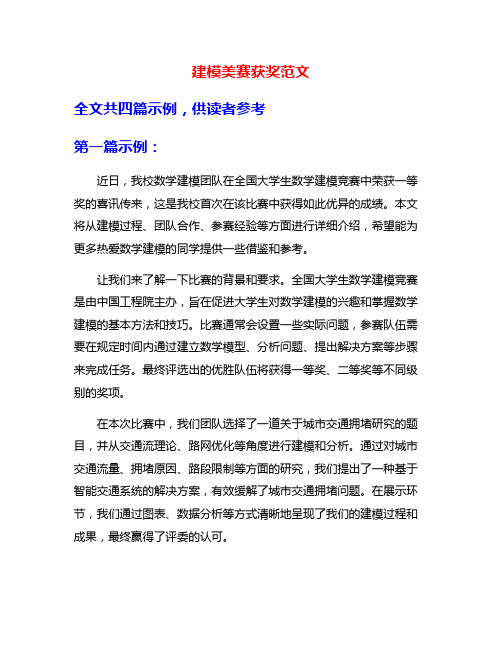
建模美赛获奖范文全文共四篇示例,供读者参考第一篇示例:近日,我校数学建模团队在全国大学生数学建模竞赛中荣获一等奖的喜讯传来,这是我校首次在该比赛中获得如此优异的成绩。
本文将从建模过程、团队合作、参赛经验等方面进行详细介绍,希望能为更多热爱数学建模的同学提供一些借鉴和参考。
让我们来了解一下比赛的背景和要求。
全国大学生数学建模竞赛是由中国工程院主办,旨在促进大学生对数学建模的兴趣和掌握数学建模的基本方法和技巧。
比赛通常会设置一些实际问题,参赛队伍需要在规定时间内通过建立数学模型、分析问题、提出解决方案等步骤来完成任务。
最终评选出的优胜队伍将获得一等奖、二等奖等不同级别的奖项。
在本次比赛中,我们团队选择了一道关于城市交通拥堵研究的题目,并从交通流理论、路网优化等角度进行建模和分析。
通过对城市交通流量、拥堵原因、路段限制等方面的研究,我们提出了一种基于智能交通系统的解决方案,有效缓解了城市交通拥堵问题。
在展示环节,我们通过图表、数据分析等方式清晰地呈现了我们的建模过程和成果,最终赢得了评委的认可。
在整个建模过程中,团队合作起着至关重要的作用。
每个成员都发挥了自己的专长和优势,在分析问题、建模求解、撰写报告等方面各司其职。
团队内部的沟通和协作非常顺畅,大家都能积极提出自己的想法和看法,达成共识后再进行实际操作。
通过团队合作,我们不仅完成了比赛的任务,也培养了团队精神和合作能力,这对我们日后的学习和工作都具有重要意义。
参加数学建模竞赛是一次非常宝贵的经历,不仅能提升自己的数学建模能力,也能锻炼自己的解决问题的能力和团队协作能力。
在比赛的过程中,我们学会了如何快速建立数学模型、如何分析和解决实际问题、如何展示自己的成果等,这些能力对我们未来的学习和工作都将大有裨益。
在未来,我们将继续努力,在数学建模领域不断学习和提升自己的能力,为更多的实际问题提供有效的数学解决方案。
我们也希望通过自己的经验和教训,为更多热爱数学建模的同学提供一些指导和帮助,共同进步,共同成长。
数学建模美赛论文格式中文版Word版
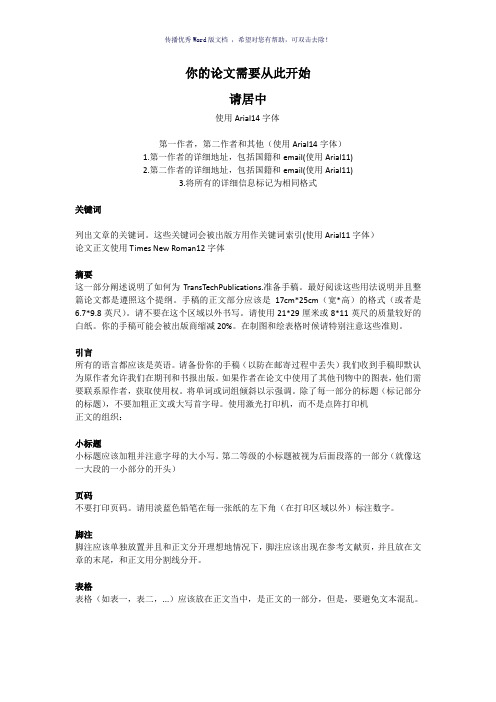
你的论文需要从此开始请居中使用Arial14字体第一作者,第二作者和其他(使用Arial14字体)1.第一作者的详细地址,包括国籍和email(使用Arial11)2.第二作者的详细地址,包括国籍和email(使用Arial11)3.将所有的详细信息标记为相同格式关键词列出文章的关键词。
这些关键词会被出版方用作关键词索引(使用Arial11字体)论文正文使用Times New Roman12字体摘要这一部分阐述说明了如何为TransTechPublications.准备手稿。
最好阅读这些用法说明并且整篇论文都是遵照这个提纲。
手稿的正文部分应该是17cm*25cm(宽*高)的格式(或者是6.7*9.8英尺)。
请不要在这个区域以外书写。
请使用21*29厘米或8*11英尺的质量较好的白纸。
你的手稿可能会被出版商缩减20%。
在制图和绘表格时候请特别注意这些准则。
引言所有的语言都应该是英语。
请备份你的手稿(以防在邮寄过程中丢失)我们收到手稿即默认为原作者允许我们在期刊和书报出版。
如果作者在论文中使用了其他刊物中的图表,他们需要联系原作者,获取使用权。
将单词或词组倾斜以示强调。
除了每一部分的标题(标记部分的标题),不要加粗正文或大写首字母。
使用激光打印机,而不是点阵打印机正文的组织:小标题小标题应该加粗并注意字母的大小写。
第二等级的小标题被视为后面段落的一部分(就像这一大段的一小部分的开头)页码不要打印页码。
请用淡蓝色铅笔在每一张纸的左下角(在打印区域以外)标注数字。
脚注脚注应该单独放置并且和正文分开理想地情况下,脚注应该出现在参考文献页,并且放在文章的末尾,和正文用分割线分开。
表格表格(如表一,表二,...)应该放在正文当中,是正文的一部分,但是,要避免文本混乱。
一个描述性的表格标题要放在图表的下方。
标题应该独立的放在表格的下方或旁边。
表中的单位应放在中括号中[兆伏]如果中括号不可用,需使用大括号{兆}或小括号(兆)。
美赛-数学建模-写作模板课件-摘要

使用专业术语
摘要中应使用与论文主题 相关的专业术语,以体现 论文的专业性和深度。
突出关键词
摘要中应突出关键词,以 便读者快速了解论文的主 题和主要内容。
突出重点
强调研究目的
摘要应明确指出研究的目 的和目标,以及研究的重 要性和意义。
突出主要发现
摘要中应突出论文的主要 发现或结论,以引起读者 的兴趣和好奇心。
强调研究方法
对于实验或实证研究,摘 要中应简要介绍研究方法, 以增加论文的可信度和说 服力。
保持连贯性
逻辑清晰
使用过渡句
摘要的逻辑应清晰,各部分内容之间 应相互衔接,形成一个完整的整体。
在摘要的不同部分之间,应使用过渡 句来连接,以增强摘要的连贯性和流 畅性。
结构完整
摘要应包含引言、方法、结果和结论 等部分,以确保内容的完整性和连贯 性。
帮助编辑和审稿人评估文章
总结和概括整篇文章
摘要也是编辑和审稿人在评估文章是否适 合发表或是否值得审稿时的重要依据。
摘要需要对整篇文章或报告的内容进行总 结和概括,因此需要作者对文章或报告有 深入的理解和把握。
02 摘要的写作技巧
精炼语言
01
02
03
避免冗余和重复
摘要应简洁明了,避免使 用过多的修饰语和重复的 表述。
精炼内容
删除不必要的描述,突出重点, 使摘要更加紧凑。
调整结构
合理安排摘要的逻辑结构,使其 条理清晰、层次分明。
05 摘要的示例与点评
优秀摘要示例
摘要应简明扼要地概括整个论文 的主要内容和结论,包括问题定 义、模型建立、求解方法和主要
结果。
优秀摘要应具有清晰的结构,使 用简洁明了的语言,避免冗长和
美国大学生数学建模大赛英文写作
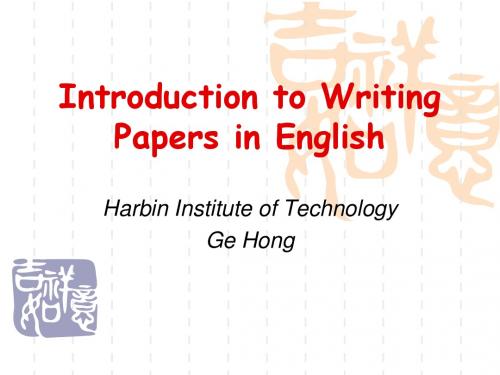
多用名词群
如: data transmission systems; high precision instrument;
句式结构(Sentence Structure)
陈述句多 科学论文中,在描述实验、说明现象、明确 定义、表达定理、定律和原理时,多用陈 述句,很少使用疑问句,几乎不用感叹句 如:Gathering facts, confirming them,
多用复合词
如:self-design, cross-sectional, dust-free, water-proof, input-orientation, piece-wiselinear 利用缩略词 如:e.g., i.e., vs.(与…相对), ibid.(出处相同), etc., cit.(在上述引文中), et al.(等人), viz.(即,就是), DEA (data envelopment analysis), OLS(Ordinary least-squares)
“Investigation on …”, “Observation on …”, “The Method of …”, “Some thought on…”, “A research on…”等冗余套语 。
4. 少用问题性标题 5. 避免名词与动名词混杂使用 如:标题是 “The Treatment of Heating and Eutechticum of Steel” 宜改为 “Heating and Eutechticuming of Steel” 6. 避免使用非标准化的缩略语 论文标题要 求简洁,但一般不使用缩略语 ,更不能使用 非标准化的缩略语 。
主题句= what 指出论文主要是什么内容 展开句= how 进一步阐明主题句的具体内 容,指出研究方法、分析过程及论证的要 点等。 结尾句= what 是全文作出的结论或补充交 代等,即得出何种结论、结果或其意义。 4. 内容完整 完整的内容主要包括四个方面: ①研究的目的和范围;② 研究的方法;③ 研究的结果;④ 作者对研究的主要结论等。
【完整解析】美赛-数学建模-写作模版(各部分)
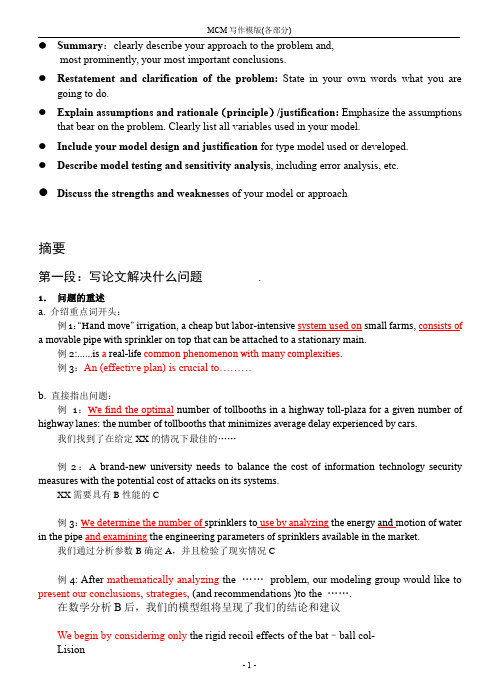
Summary:clearly describe your approach to the problem and,most prominently,your most important conclusions.●Restatement and clarification of the problem:State in your own words what you aregoing to do.●Explain assumptions and rationale(principle)/justification:Emphasize the assumptionsthat bear on the problem.Clearly list all variables used in your model.●Include your model design and justification for type model used or developed.●Describe model testing and sensitivity analysis,including error analysis,etc.●Discuss the strengths and weaknesses of your model or approach摘要第一段:写论文解决什么问题.1.问题的重述a.介绍重点词开头:例1:“Hand move”irrigation,a cheap but labor-intensive system used on small farms,consists of a movable pipe with sprinkler on top that can be attached to a stationary main.例2:……is a real-life common phenomenon with many complexities.例3:An(effective plan)is crucial to………b.直接指出问题:例1:We find the optimal number of tollbooths in a highway toll-plaza for a given number of highway lanes:the number of tollbooths that minimizes average delay experienced by cars.我们找到了在给定XX的情况下最佳的……例2:A brand-new university needs to balance the cost of information technology security measures with the potential cost of attacks on its systems.XX需要具有B性能的C例3:We determine the number of sprinklers to use by analyzing the energy and motion of water in the pipe and examining the engineering parameters of sprinklers available in the market.我们通过分析参数B确定A,并且检验了现实情况C例4:After mathematically analyzing the……problem,our modeling group would like to present our conclusions,strategies,(and recommendations)to the…….在数学分析B后,我们的模型组将呈现了我们的结论和建议We begin by considering only the rigid recoil effects of the bat–ball col-LisionOur main goal is to understand the sweet spot.A secondary goal is tounderstand the differences between the sweet spots of different bat types.Because the collision happens on such a short time-scale(around1ms),we treat the bat as a free body.That is to say,we are not concerned with the batter’s hands exerting force on the bat that may be transferred to the ball....Our paper is organized as follows....例5:Our goal is...that(minimizes the time)……….2.解决这个问题的伟大意义反面说明。
数学建模范文模板

数学建模范文模板一、问题分析1. 问题的背景与意义:(1)简要介绍问题的相关背景与意义;(2)问题的研究价值和应用前景。
2. 问题的具体描述:(1)详细描述问题的具体内容,包括已知条件和需要求解的问题;(2)对问题进行可视化分析,如示意图、数据表格等。
3. 问题的假设:(1)对问题进行一些合理的假设,以简化问题;(2)明确各种假设的合理性和局限性。
二、模型的建立1. 模型的基本思路:(1)根据问题的具体情况,提出解决问题的基本思路、方法或策略;(2)形成数学模型的核心思想。
2. 模型的符号定义:(1)对模型中所用到的符号进行明确的定义;(2)解释符号的含义和用途。
3. 模型的建立与求解:(1)根据问题的具体要求,建立相应的数学模型;(2)通过数学方法对模型进行求解,得到问题的最优解或近似解。
三、模型的验证与分析1. 模型的验证:(1)对建立的数学模型进行验证,检验模型的合理性;(2)通过比较模型的预测结果与现实数据或实验结果的吻合程度,判断模型的有效性。
2. 模型的结果与讨论:(1)分析模型的求解结果,阐述其具体含义和实际意义;(2)对模型的局限性和改进方向进行讨论。
四、模型的应用与推广1. 模型的应用:(1)对模型的应用范围和条件进行说明;(2)通过实际案例分析,探讨模型在解决问题中的实际应用。
2. 模型的推广:(1)对模型的推广适用性进行分析;(2)针对其他类似问题,探讨模型的推广和改进方向。
五、总结与展望1. 研究总结:(1)对已完成的研究工作进行总结,强调研究的主要成果和创新之处;(2)指出问题研究中的不足和需要进一步探索的方向。
2. 研究展望:(1)对未来的研究方向和重点进行展望;(2)对进一步提高模型的精度、拓宽应用范围等方面提出建议。
建模美赛获奖范文
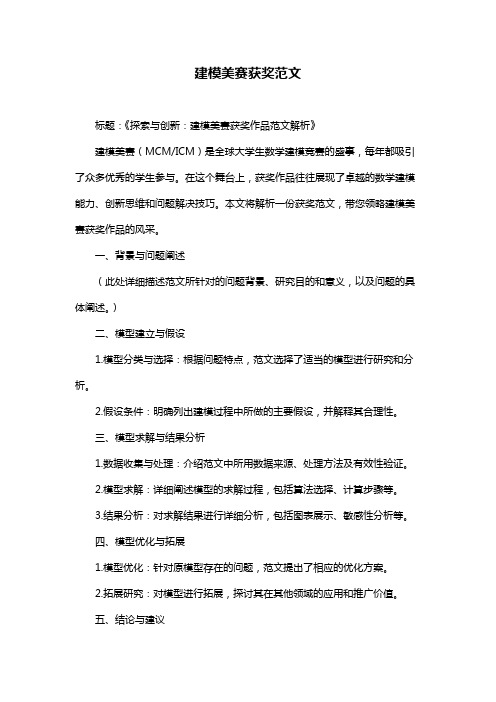
建模美赛获奖范文标题:《探索与创新:建模美赛获奖作品范文解析》建模美赛(MCM/ICM)是全球大学生数学建模竞赛的盛事,每年都吸引了众多优秀的学生参与。
在这个舞台上,获奖作品往往展现了卓越的数学建模能力、创新思维和问题解决技巧。
本文将解析一份获奖范文,带您领略建模美赛获奖作品的风采。
一、背景与问题阐述(此处详细描述范文所针对的问题背景、研究目的和意义,以及问题的具体阐述。
)二、模型建立与假设1.模型分类与选择:根据问题特点,范文选择了适当的模型进行研究和分析。
2.假设条件:明确列出建模过程中所做的主要假设,并解释其合理性。
三、模型求解与结果分析1.数据收集与处理:介绍范文中所用数据来源、处理方法及有效性验证。
2.模型求解:详细阐述模型的求解过程,包括算法选择、计算步骤等。
3.结果分析:对求解结果进行详细分析,包括图表展示、敏感性分析等。
四、模型优化与拓展1.模型优化:针对原模型存在的问题,范文提出了相应的优化方案。
2.拓展研究:对模型进行拓展,探讨其在其他领域的应用和推广价值。
五、结论与建议1.结论总结:概括范文的研究成果,强调其创新点和贡献。
2.实践意义:分析建模结果在实际问题中的应用价值和意义。
3.建议:针对问题解决,提出具体的建议和措施。
六、获奖亮点与启示1.创新思维:范文在模型选择、求解方法等方面展现出创新性。
2.严谨论证:文章结构清晰,逻辑严密,数据充分,论证有力。
3.团队合作:建模美赛强调团队协作,范文体现了成员间的紧密配合和分工合作。
总结:通过分析这份建模美赛获奖范文,我们可以学到如何从问题背景出发,建立合理的模型,进行严谨的求解和分析,以及如何优化和拓展模型。
同时,也要注重创新思维和团队合作,才能在建模美赛中脱颖而出。
美赛数学建模比赛论文资料材料模板
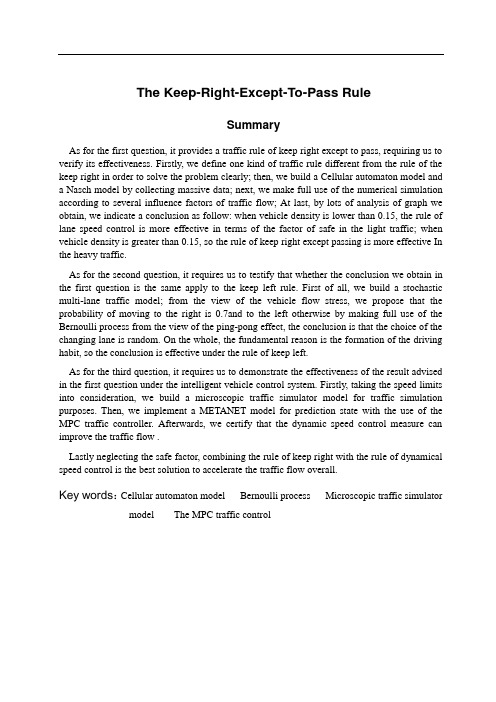
The Keep-Right-Except-To-Pass RuleSummaryAs for the first question, it provides a traffic rule of keep right except to pass, requiring us to verify its effectiveness. Firstly, we define one kind of traffic rule different from the rule of the keep right in order to solve the problem clearly; then, we build a Cellular automaton model and a Nasch model by collecting massive data; next, we make full use of the numerical simulation according to several influence factors of traffic flow; At last, by lots of analysis of graph we obtain, we indicate a conclusion as follow: when vehicle density is lower than 0.15, the rule of lane speed control is more effective in terms of the factor of safe in the light traffic; when vehicle density is greater than 0.15, so the rule of keep right except passing is more effective In the heavy traffic.As for the second question, it requires us to testify that whether the conclusion we obtain in the first question is the same apply to the keep left rule. First of all, we build a stochastic multi-lane traffic model; from the view of the vehicle flow stress, we propose that the probability of moving to the right is 0.7and to the left otherwise by making full use of the Bernoulli process from the view of the ping-pong effect, the conclusion is that the choice of the changing lane is random. On the whole, the fundamental reason is the formation of the driving habit, so the conclusion is effective under the rule of keep left.As for the third question, it requires us to demonstrate the effectiveness of the result advised in the first question under the intelligent vehicle control system. Firstly, taking the speed limits into consideration, we build a microscopic traffic simulator model for traffic simulation purposes. Then, we implement a METANET model for prediction state with the use of the MPC traffic controller. Afterwards, we certify that the dynamic speed control measure can improve the traffic flow .Lastly neglecting the safe factor, combining the rule of keep right with the rule of dynamical speed control is the best solution to accelerate the traffic flow overall.Key words:Cellular automaton model Bernoulli process Microscopic traffic simulator model The MPC traffic controlContentContent (2)1. Introduction (3)2. Analysis of the problem (3)3. Assumption (3)4. Symbol Definition (3)5. Models (3)5.1 Building of the Cellular automaton model (3)5.1.1 Verify the effectiveness of the keep right except to pass rule (4)5.1.2 Numerical simulation results and discussion (5)5.1.3 Conclusion (8)5.2 The solving of second question (8)5.2.1 The building of the stochastic multi-lane traffic model (8)5.2.2 Conclusion (8)5.3 Taking the an intelligent vehicle system into a account (8)5.3.1 Introduction of the Intelligent Vehicle Highway Systems (9)5.3.2 Control problem (9)5.3.3 Results and analysis (9)5.3.4 The comprehensive analysis of the result (9)6. Improvement of the model (10)6.1 strength and weakness (10)6.1.1 Strength (10)6.1.2 Weakness (10)6.2 Improvement of the model (10)7. Reference (12)1. IntroductionAs is known to all, it ’s essential for us to drive automobiles, thus the driving rules is crucial important. In many countries like USA, China, drivers obey the rules which called “The Keep-Right-Except-To-Pass (that is, when driving automobiles, the rule requires drivers to drive in the right-most unless they are passing another vehicle)”.2. Analysis of the problemFor the first question, we decide to use the Cellular automaton to build models, then analyze the performance of this rule in light and heavy traffic. Firstly, we mainly use the vehicle density to distinguish the light and heavy traffic; secondly, we consider the traffic flow and safe as the represent variable which denotes the light or heavy traffic; thirdly, we build and analyze a Cellular automaton model; finally, we judge the rule through two different driving rules, and then draw conclusions.3. AssumptionIn order to streamline our model we have made several key assumptions● The highway of double row three lanes that we study can representmulti-lane freeways.● The data that we refer to has certain representativeness and descriptive● Operation condition of the highway not be influenced by blizzard or accidental factors ● Ignore the driver's own abnormal factors, such as drunk driving and fatigue driving ● The operation form of highway intelligent system that our analysis can reflectintelligent system● In the intelligent vehicle system, the result of the sampling data has high accuracy.4. Symbol Definitioni The number of vehiclest The time5. ModelsBy analyzing the problem, we decided to propose a solution with building a cellular automaton model.5.1 Building of the Cellular automaton modelThanks to its simple rules and convenience for computer simulation, cellular automaton model has been widely used in the study of traffic flow in recent years.Let )(t x i be the position of vehicle i at time t , )(t v i be the speed of vehicle i at time t ,p be the random slowing down probability, and R be the proportion of trucks and buses, the distance between vehicle i and the front vehicle at time t is:1)()(1--=-t x t x gap i i i , if the front vehicle is a small vehicle.3)()(1--=-t x t x gap i i i , if the front vehicle is a truck or bus.5.1.1 Verify the effectiveness of the keep right except to pass ruleIn addition, according to the keep right except to pass rule, we define a new rule called: Control rules based on lane speed. The concrete explanation of the new rule as follow:There is no special passing lane under this rule. The speed of the first lane (the far left lane) is 120–100km/h (including 100 km/h);the speed of the second lane (the middle lane) is 100–80km8/h (including80km/h);the speed of the third lane (the far right lane) is below 80km/ h. The speeds of lanes decrease from left to right.● Lane changing rules based lane speed controlIf vehicle on the high-speed lane meets control v v <, ),1)(min()(max v t v t gap i f i +≥, safe b i gap t gap ≥)(, the vehicle will turn into the adjacent right lane, and the speed of the vehicle after lane changing remains unchanged, where control v is the minimum speed of the corresponding lane.● The application of the Nasch model evolutionLet d P be the lane changing probability (taking into account the actual situation that some drivers like driving in a certain lane, and will not take the initiative to change lanes), )(t gap f i indicates the distance between the vehicle and the nearest front vehicle, )(t gap b i indicates the distance between the vehicle and the nearest following vehicle. In this article, we assume that the minimum safe distance gap safe of lane changing equals to the maximum speed of the following vehicle in the adjacent lanes.● Lane changing rules based on keeping right except to passIn general, traffic flow going through a passing zone (Fig. 5.1.1) involves three processes: the diverging process (one traffic flow diverging into two flows), interacting process (interacting between the two flows), and merging process (the two flows merging into one)[4].Fig.5.1.1 Control plan of overtaking process(1) If vehicle on the first lane (passing lane) meets ),1)(min()(max v t v t gap i f i +≥ and safe b i gap t gap ≥)(, the vehicle will turn into the second lane, the speed of the vehicle after lane changing remains unchanged.5.1.2 Numerical simulation results and discussionIn order to facilitate the subsequent discussions, we define the space occupation rate as L N N p truck CAR ⨯⨯+=3/)3(, where CAR N indicates the number of small vehicles on the driveway,truck N indicates the number of trucks and buses on the driveway, and L indicates the total length of the road. The vehicle flow volume Q is the number of vehicles passing a fixed point per unit time,T N Q T /=, where T N is the number of vehicles observed in time duration T .The average speed ∑∑⨯=T it i a v T N V 11)/1(, t i v is the speed of vehicle i at time t . Take overtaking ratio f p as the evaluation indicator of the safety of traffic flow, which is the ratio of the total number of overtaking and the number of vehicles observed. After 20,000 evolution steps, and averaging the last 2000 steps based on time, we have obtained the following experimental results. In order to eliminate the effect of randomicity, we take the systemic average of 20 samples [5].Overtaking ratio of different control rule conditionsBecause different control conditions of road will produce different overtaking ratio, so we first observe relationships among vehicle density, proportion of large vehicles and overtaking ratio under different control conditions.(a) Based on passing lane control (b) Based on speed controlFig.5.1.3Fig.5.1.3Relationships among vehicle density, proportion of large vehicles and overtaking ratio under different control conditions.It can be seen from Fig. 5.1.3:(1) when the vehicle density is less than 0.05, the overtaking ratio will continue to rise with the increase of vehicle density; when the vehicle density is larger than 0.05, the overtaking ratio will decrease with the increase of vehicle density; when density is greater than 0.12, due to the crowding, it will become difficult to overtake, so the overtaking ratio is almost 0.(2) when the proportion of large vehicles is less than 0.5, the overtaking ratio will rise with the increase of large vehicles; when the proportion of large vehicles is about 0.5, the overtaking ratio will reach its peak value; when the proportion of large vehicles is larger than 0.5, the overtaking ratio will decrease with the increase of large vehicles, especially under lane-based control condition s the decline is very clear.Concrete impact of under different control rules on overtaking ratioFig.5.1.4Fig.5.1.4 Relationships among vehicle density, proportion of large vehicles and overtaking ratio under different control conditions. (Figures in left-hand indicate the passing lane control, figures in right-hand indicate thespeed control. 1f P is the overtaking ratio of small vehicles over large vehicles, 2f P is the overtaking ratio ofsmall vehicles over small vehicles, 3f P is the overtaking ratio of large vehicles over small vehicles, 4f P is the overtaking ratio of large vehicles over large vehicles.).It can be seen from Fig. 5.1.4:(1) The overtaking ratio of small vehicles over large vehicles under passing lane control is much higher than that under speed control condition, which is because, under passing lane control condition, high-speed small vehicles have to surpass low-speed large vehicles by the passing lane, while under speed control condition, small vehicles are designed to travel on the high-speed lane, there is no low- speed vehicle in front, thus there is no need to overtake. ● Impact of different control rules on vehicle speedFig. 5.1.5 Relationships among vehicle density, proportion of large vehicles and average speed under different control conditions. (Figures in left-hand indicates passing lane control, figures in right-hand indicates speed control. a X is the average speed of all the vehicles, 1a X is the average speed of all the small vehicles, 2a X is the average speed of all the buses and trucks.).It can be seen from Fig. 5.1.5:(1) The average speed will reduce with the increase of vehicle density and proportion of large vehicles.(2) When vehicle density is less than 0.15,a X ,1a X and 2a X are almost the same under both control conditions.● Effect of different control conditions on traffic flowFig.5.1.6Fig. 5.1.6Relationships among vehicle density, proportion of large vehicles and traffic flow under different control conditions. (Figure a1 indicates passing lane control, figure a2 indicates speed control, and figure b indicates the traffic flow difference between the two conditions.It can be seen from Fig. 5.1.6:(1) When vehicle density is lower than 0.15 and the proportion of large vehicles is from 0.4 to 1, the traffic flow of the two control conditions are basically the same.(2) Except that, the traffic flow under passing lane control condition is slightly larger than that of speed control condition.5.1.3 ConclusionIn this paper, we have established three-lane model of different control conditions, studied the overtaking ratio, speed and traffic flow under different control conditions, vehicle density and proportion of large vehicles.5.2 The solving of second question5.2.1 The building of the stochastic multi-lane traffic model5.2.2 ConclusionOn one hand, from the analysis of the model, in the case the stress is positive, we also consider the jam situation while making the decision. More specifically, if a driver is in a jam BP(situation, applying ))results with a tendency of moving to the right lane for this,2(xRdriver. However in reality, drivers tend to find an emptier lane in a jam situation. For this reason, we apply a Bernoulli process )7.0,2(B where the probability of moving to the right is 0.7and to the left otherwise, and the conclusion is under the rule of keep left except to pass, So, the fundamental reason is the formation of the driving habit.5.3 Taking the an intelligent vehicle system into a accountFor the third question, if vehicle transportation on the same roadway was fully under the control of an intelligent system, we make some improvements for the solution proposed by usto perfect the performance of the freeway by lots of analysis.5.3.1 Introduction of the Intelligent Vehicle Highway SystemsWe will use the microscopic traffic simulator model for traffic simulation purposes. The MPC traffic controller that is implemented in the Matlab needs a traffic model to predict the states when the speed limits are applied in Fig.5.3.1. We implement a METANET model for prediction purpose[14].5.3.2 Control problemAs a constraint, the dynamic speed limits are given a maximum and minimum allowed value. The upper bound for the speed limits is 120 km/h, and the lower bound value is 40 km/h. For the calculation of the optimal control values, all speed limits are constrained to this range. When the optimal values are found, they are rounded to a multiplicity of 10 km/h, since this is more clear for human drivers, and also technically feasible without large investments.5.3.3 Results and analysisWhen the density is high, it is more difficult to control the traffic, since the mean speed might already be below the control speed. Therefore, simulations are done using densities at which the shock wave can dissolve without using control, and at densities where the shock wave remains. For each scenario, five simulations for three different cases are done, each with a duration of one hour. The results of the simulations are reported in Table5.1, 5.2, 5.3.●Enforced speed limits●Intelligent speed adaptationFor the ISA scenario, the desired free-flow speed is about 100% of the speed limit. The desired free-flow speed is modeled as a Gaussian distribution, with a mean value of 100% of the speed limit, and a standard deviation of 5% of the speed limit. Based on this percentage, the influence of the dynamic speed limits is expected to be good[19].5.3.4 The comprehensive analysis of the resultFrom the analysis above, we indicate that adopting the intelligent speed control system can effectively decrease the travel times under the control of an intelligent system, in other words, the measures of dynamic speed control can improve the traffic flow.Evidently, under the intelligent speed control system, the effect of the dynamic speed control measure is better than that under the lane speed control mentioned in the first problem. Becauseof the application of the intelligent speed control system, it can provide the optimal speed limit in time. In addition, it can guarantee the safe condition with all kinds of detection device and the sensor under the intelligent speed system.On the whole, taking all the analysis from the first problem to the end into a account, when it is in light traffic, we can neglect the factor of safe with the help of the intelligent speed control system.Thus, under the state of the light traffic, we propose a new conclusion different from that in the first problem: the rule of keep right except to pass is more effective than that of lane speed control.And when it is in the heavy traffic, for sparing no effort to improve the operation efficiency of the freeway, we combine the dynamical speed control measure with the rule of keep right except to pass, drawing a conclusion that the application of the dynamical speed control can improve the performance of the freeway.What we should highlight is that we can make some different speed limit as for different section of road or different size of vehicle with the application of the Intelligent Vehicle Highway Systems.In fact, that how the freeway traffic operate is extremely complex, thereby, with the application of the Intelligent Vehicle Highway Systems, by adjusting our solution originally, we make it still effective to freeway traffic.6. Improvement of the model6.1 strength and weakness6.1.1 Strength●it is easy for computer simulating and can be modified flexibly to consider actual trafficconditions ,moreover a large number of images make the model more visual.●The result is effectively achieved all of the goals we set initially, meantime the conclusion ismore persuasive because of we used the Bernoulli equation.●We can get more accurate result as we apply Matlab.6.1.2 Weakness●The relationship between traffic flow and safety is not comprehensively analysis.●Due to there are many traffic factors, we are only studied some of the factors, thus ourmodel need further improved.6.2 Improvement of the modelWhile we compare models under two kinds of traffic rules, thereby we come to the efficiency of driving on the right to improve traffic flow in some circumstance. Due to the rules of comparing is too less, the conclusion is inadequate. In order to improve the accuracy, Wefurther put forward a kinds of traffic rules: speed limit on different type of cars.The possibility of happening traffic accident for some vehicles is larger, and it also brings hidden safe troubles. So we need to consider separately about different or specific vehicle types from the angle of the speed limiting in order to reduce the occurrence of traffic accidents, the highway speed limit signs is in Fig.6.1.Fig.6.1Advantages of the improving model are that it is useful to improve the running condition safety of specific type of vehicle while considering the difference of different types of vehicles. However, we found that the rules may be reduce the road traffic flow through the analysis. In the implementation it should be at the85V speed of each model as the main reference basis. Inrecent years, the85V of some researchers for the typical countries from Table 6.1[ 21]:Author Country ModelOttesen andKrammes2000America LCDCLDCVC⨯---=01.0012.057.144.10285Andueza2000 Venezuela].[308.9486.7)/894()/2795(25.9885curvehorizontalLDCRaRVT++--=].[tan819.27)/3032(69.10085gentLRVT+-=Jessen2001 America][00239.0614.0279.080.86185LSDADTGVVP--+=][00212.0432.010.7285NLSDADTVVP-+=Donnell2001 America22)2(8500724.040.10140.04.78TLGRV--+=22)3(85008369.048.10176.01.75TLGRV--+=22)4(8500810.069.10176.05.74TLGRV--+=22)5(8500934.008.21.83TLGV--=BucchiA.BiasuzziK.And SimoneA.2005 ItalyDCV124.0164.6685-=DCEV4.046.3366.5585--=Meanwhile, there are other vehicles driving rules such as speed limit in adverse weather conditions. This rule can improve the safety factor of the vehicle to some extent. At the same time, it limits the speed at the different levels.7. Reference[1] M. Rickert, K. Nagel, M. Schreckenberg, A. Latour, Two lane traffic simulations usingcellular automata, Physica A 231 (1996) 534–550.[20] J.T. Fokkema, Lakshmi Dhevi, Tamil Nadu Traffic Management and Control inIntelligent Vehicle Highway Systems,18(2009).[21] Yang Li, New Variable Speed Control Approach for Freeway. (2011) 1-66。
【完整解析】美赛-数学建模-写作模版(各部分)
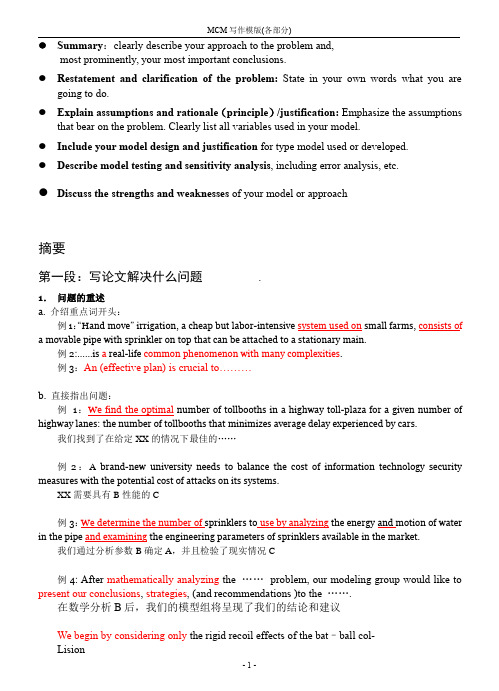
Summary:clearly describe your approach to the problem and,most prominently,your most important conclusions.●Restatement and clarification of the problem:State in your own words what you aregoing to do.●Explain assumptions and rationale(principle)/justification:Emphasize the assumptionsthat bear on the problem.Clearly list all variables used in your model.●Include your model design and justification for type model used or developed.●Describe model testing and sensitivity analysis,including error analysis,etc.●Discuss the strengths and weaknesses of your model or approach摘要第一段:写论文解决什么问题.1.问题的重述a.介绍重点词开头:例1:“Hand move”irrigation,a cheap but labor-intensive system used on small farms,consists of a movable pipe with sprinkler on top that can be attached to a stationary main.例2:……is a real-life common phenomenon with many complexities.例3:An(effective plan)is crucial to………b.直接指出问题:例1:We find the optimal number of tollbooths in a highway toll-plaza for a given number of highway lanes:the number of tollbooths that minimizes average delay experienced by cars.我们找到了在给定XX的情况下最佳的……例2:A brand-new university needs to balance the cost of information technology security measures with the potential cost of attacks on its systems.XX需要具有B性能的C例3:We determine the number of sprinklers to use by analyzing the energy and motion of water in the pipe and examining the engineering parameters of sprinklers available in the market.我们通过分析参数B确定A,并且检验了现实情况C例4:After mathematically analyzing the……problem,our modeling group would like to present our conclusions,strategies,(and recommendations)to the…….在数学分析B后,我们的模型组将呈现了我们的结论和建议We begin by considering only the rigid recoil effects of the bat–ball col-LisionOur main goal is to understand the sweet spot.A secondary goal is tounderstand the differences between the sweet spots of different bat types.Because the collision happens on such a short time-scale(around1ms),we treat the bat as a free body.That is to say,we are not concerned with the batter’s hands exerting force on the bat that may be transferred to the ball....Our paper is organized as follows....例5:Our goal is...that(minimizes the time)……….2.解决这个问题的伟大意义反面说明。
美赛-数学建模-写作模版(各部分)讲课稿
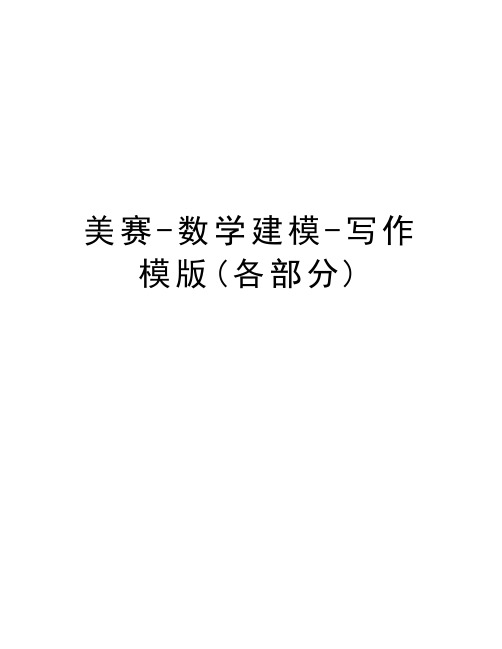
美赛-数学建模-写作模版(各部分)摘要第一段:写论文解决什么问题1.问题的重述a. 介绍重点词开头:例1:“Hand move” irrigation, a cheap but labor-intensive system used on small farms, consists of a movable pipe with sprinkler on top that can be attached to a stationary main.例2:……is a real-life common phenomenon with many complexities.例3:An (effective plan) is crucial to………b. 直接指出问题:例 1:We find the optimal number of tollbooths in a highway toll-plaza for a given number of highway lanes: the number of tollbooths that minimizes average delay experienced by cars.例2:A brand-new university needs to balance the cost of information technology security measures with the potential cost of attacks on its systems.例3:We determine the number of sprinklers to use by analyzing the energy and motion of water in the pipe and examining the engineering parameters of sprinklers available in the market.例4: After mathematically analyzing the …… problem, our modeling group would like to present our conclusions, strategies, (and recommendations )to the …….例5:Our goal is... that (minimizes the time )……….2.解决这个问题的伟大意义反面说明。
数学建模美赛写作模版(包含摘要、格式、总结、表格、公式、图表、假设)
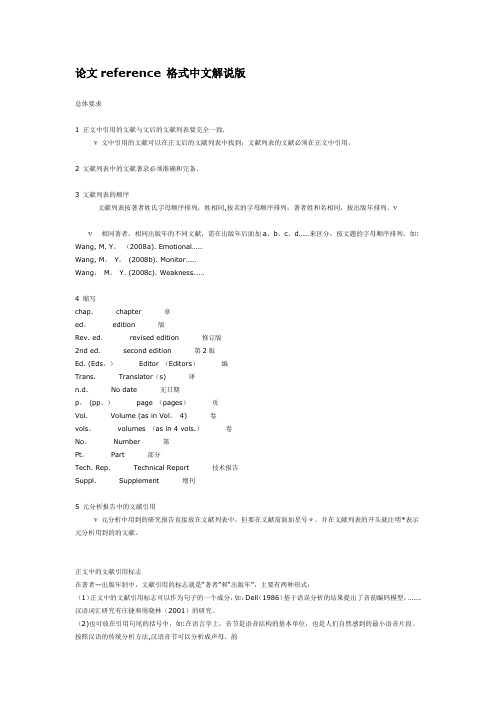
论文reference 格式中文解说版总体要求1 正文中引用的文献与文后的文献列表要完全一致.ν文中引用的文献可以在正文后的文献列表中找到;文献列表的文献必须在正文中引用。
2 文献列表中的文献著录必须准确和完备。
3 文献列表的顺序文献列表按著者姓氏字母顺序排列;姓相同,按名的字母顺序排列;著者姓和名相同,按出版年排列。
νν相同著者,相同出版年的不同文献,需在出版年后面加a、b、c、d……来区分,按文题的字母顺序排列。
如: Wang, M. Y。
(2008a). Emotional……Wang, M。
Y。
(2008b). Monitor……Wang,M。
Y. (2008c). Weakness……4 缩写chap. chapter 章ed。
edition 版Rev. ed。
revised edition 修订版2nd ed. second edition 第2版Ed. (Eds。
)Editor (Editors)编Trans. Translator(s) 译n.d. No date 无日期p。
(pp。
)page (pages)页Vol. Volume (as in Vol。
4) 卷vols。
volumes (as in 4 vols.)卷No。
Number 第Pt。
Part 部分Tech. Rep. Technical Report 技术报告Suppl. Supplement 增刊5 元分析报告中的文献引用ν元分析中用到的研究报告直接放在文献列表中,但要在文献前面加星号*。
并在文献列表的开头就注明*表示元分析用到的的文献。
正文中的文献引用标志在著者—出版年制中,文献引用的标志就是“著者”和“出版年”,主要有两种形式:(1)正文中的文献引用标志可以作为句子的一个成分,如:Dell(1986)基于语误分析的结果提出了音韵编码模型,…….汉语词汇研究有庄捷和周晓林(2001)的研究。
(2)也可放在引用句尾的括号中,如:在语言学上,音节是语音结构的基本单位,也是人们自然感到的最小语音片段。
正确写作美国大学生数学建模竞赛论文
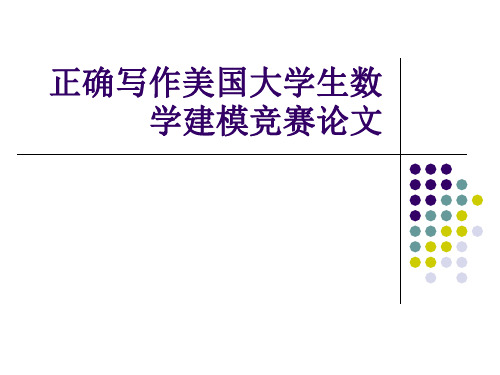
1)、鉴别阶段: (10分钟)
所有论文在此阶段按其质量分别归入一下三类:第一类 是可以进入下一评审阶段的论文(略少于二分之一);第二类 是满足竞赛要求,但不足以进入下一评审阶段的论文(这一类 就被定为合格论文);第三类是不符合竞赛要求的论文(不合 格论文)。 由于在第一阶段中,评委只有10分钟左右的时间评审一 篇论文,因此评委常常只能通过阅读摘要来判断论文水平的高 低。
例如,2010年MCM竞赛中有一道赛题,要求参赛小 组根据以往的作案地点预测连环犯罪的位置。
3.1)、假设条件和解释 解答这道赛题的重点是犯罪活动方式。在一篇题为 “Centroids, Clusters, and Crime: Anchoring the Geographic Profiles of Serial Criminals”的论文中,有一条假设是“罪犯 的活动不受限制”,但罪犯是在市区的活动,实际上会受 到街道的布局及街道两旁建筑物的限制。由于街道布局通 常类似于网格,所以参赛小组对这个假设做了如下解释: Criminal’s movement is unconstrained. Because of the difficulty of finding real-world distance data, we invoke the „Manhattan assumption‟: There are enough streets and sidewalks in a sufficiently grid-like pattern that movements along real-world movement routes is the same as „straight-line‟ movement in a space discretized into city blocks…
- 1、下载文档前请自行甄别文档内容的完整性,平台不提供额外的编辑、内容补充、找答案等附加服务。
- 2、"仅部分预览"的文档,不可在线预览部分如存在完整性等问题,可反馈申请退款(可完整预览的文档不适用该条件!)。
- 3、如文档侵犯您的权益,请联系客服反馈,我们会尽快为您处理(人工客服工作时间:9:00-18:30)。
摘要第一段:写论文解决什么问题1.问题的重述a. 介绍重点词开头:例1:“Hand move” irrigation, a cheap but labor-intensive system used on small farms, consists of a movable pipe with sprinkler on top that can be attached to a stationary main.例2:……is a real-life common phenomenon with many complexities.例3:An (effective plan) is crucial to………b. 直接指出问题:例1:We find the optimal number of tollbooths in a highway toll-plaza for a given number of highway lanes: the number of tollbooths that minimizes average delay experienced by cars.例2:A brand-new university needs to balance the cost of information technology security measures with the potential cost of attacks on its systems.例3:We determine the number of sprinklers to use by analyzing the energy and motion of water in the pipe and examining the engineering parameters of sprinklers available in the market.例4: After mathematically analyzing the ……problem, our modeling group would like to present our conclusions, strategies, (and recommendations )to the …….例5:Our goal is... that (minimizes the time )……….2.解决这个问题的伟大意义反面说明。
如果没有……Without implementing defensive measure, the university is exposed to an expected loss of $8.9 million per year.3.总的解决概述a.通过什么方法解决什么问题例:We address the problem of optimizing amusement park enjoyment through distributing Quick Passes (QP), reservation slips that ideally allow an individual to spend less time waiting in line.b.实际问题转化为数学模型例1 We formulate the problem as a network flow in which vertices are the locations of escorts and wheelchair passengers.例2 : A naïve strategy would be to employ the minimum number of escorts to guarantee that all passengers reach their gates on time.c.将问题分阶段考虑例3:We divide the jump into three phases: flying through the air, punching through the stack, and landing on the ground.第二、三段:具体分析1.在什么模型中/ 建立了什么模型a. 主流模型例1:We formulate a differential model to account for the rates of change of these uses, and how this change would affect the overall consumption of water within the studied region.例2:We examined the mathematical effects of……. We developed a detailed……(simulation methodology) to test our ideas and to quantify the differences between (among) different ……(strategies).例3:Based on (write your basis .such as the theory of supply and demand), we establish a model (such as differential equation system that includes demand, supply).例4:To (write the aims), we establish a criterion (write the criterion).b. 模型非主流例5:We build a model to determine how to lay out the pipe each time the equipment is moved.例6:We determine…………例7:We build a model to determine……….例8:We formulate a model for………By analyzing…and examining…..2.分析模型(使用什么数据,怎么做,一般三句话)a. 写历史数据例1:Using historical data from the United States, we determine initial conditions for our model.b. 写计算机模拟例1:this model leads to a computer simulation of catch-can tests of the irrigation system and……例2:Software packing reaches………by calculating and comparing………..c. 运用数据模拟例1:to ground this model in reality, we incorporate extensive demographic data and run……例2:We fit the modified model to data (such as 1970-2003.). We conclude that(write the last conclude).d. 讲详细分析例1:We physically characterize the system that…例2:We provide a strategy (write the logical strategy).例3:The …model is (efficient, intuitive, and flexible) and could be applied to…例4:To meet the needs of people today without, we establish a criterion of rational(合理的标准) oil allocation(分配).3.总结该模型的结果/得到什么结论a. 说明不是最优但能产生作用例:We show that this strategy is not optimal but can be improved by assigning different numbers……b. 说明如果用这个模型,结果如何例1:If Delta Airlines were to utilize the naïve strategy at Atlanta International Airport, the cost would be……例2:We modify the model to reflect(some trend such as exponentially increasing……) and generalize the model to (other field).例3:Our results are summarized in the formula for the optimal number Bof tollbooths for c.通过其上情况的列举得到的结论例:For various situations, we propose an optimal solution.d. 得出了结论例1:we elicit that a conclusion.例2:We conclude with a series of recommendations for how best to…e.进一步说明其他因素对模型的影响例:In addition to the model, we also discuss policies for …..f.用真实数据检验模型例:To demonstrate how our model works, we apply it to ………..最后一段:写总的结论a. 说明结论的可行性例:Our suggested solution, which is easy to implement, includes a detailed timetable and the arrangement of pipes.b.说明算法的广泛性例1:Our algorithm is broad enough to accommodate various airport concourses, flight schedules, and flight delays.例2:Our analysis began by determining what factor impact……, Our conclusions are presented……c.说明模型可用于其他领域例:Since our model is based on…… it can be applied to (other domain).其他(承上启下的连接词/常用词组)例:In addition to the model, we also discuss……引言部分(1)回顾研究背景,常用词汇有review, summarize, present, outline, describe等(2)说明写作目的,常用词汇有purpose, attempt, aim等,另外还可以用动词不定式充当目的状语来表达(3)介绍论文的重点内容或研究范围,常用词汇有study, present, include, focus, emphasize, emphasis, attention等方法部分(1)介绍研究或试验过程,常用词汇有test study, investigate, examine, experiment, discuss, consider, analyze, analysis等(2)说明研究或试验方法,常用词汇有measure, estimate, calculate等(3)介绍应用、用途,常用词汇有等结果部分(1)展示研究结果,常用词汇有show, result, present等(2)介绍结论,常用词汇有summary, introduce, conclude等讨论部分(1)陈述论文的论点和作者的观点,常用词汇有suggest, repot, present, expect, describe等(2)说明论证,常用词汇有等support, provide, indicate, identify, find, demonstrate, confirm, clarify(3)推荐和建议,常用词汇有suggest, suggestion, recommend, recommendation, propose, necessity, necessary, expect等。
